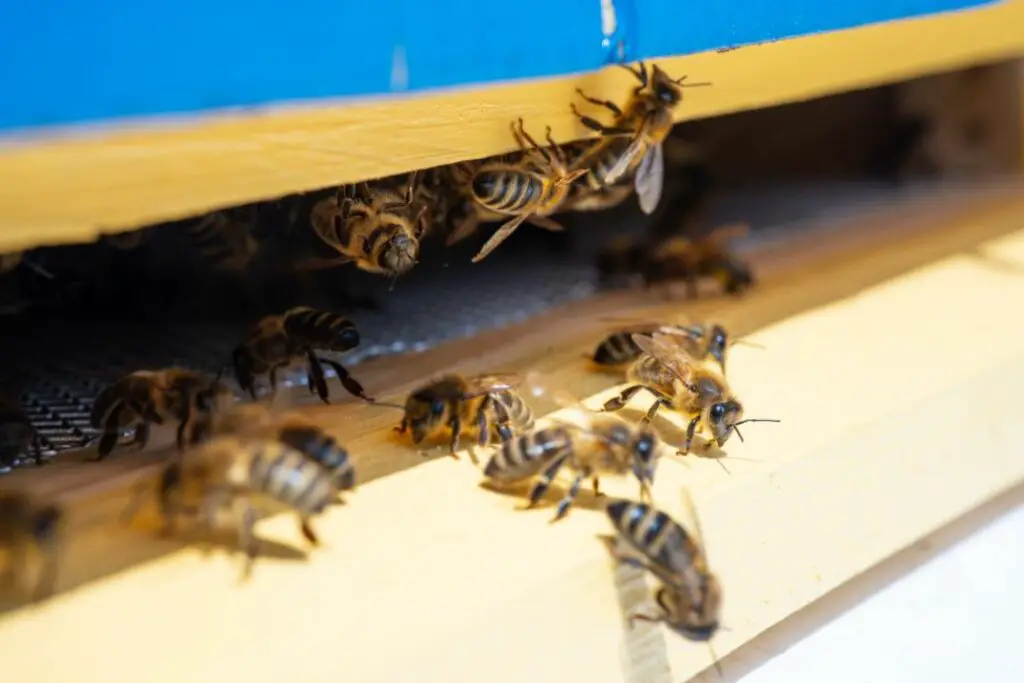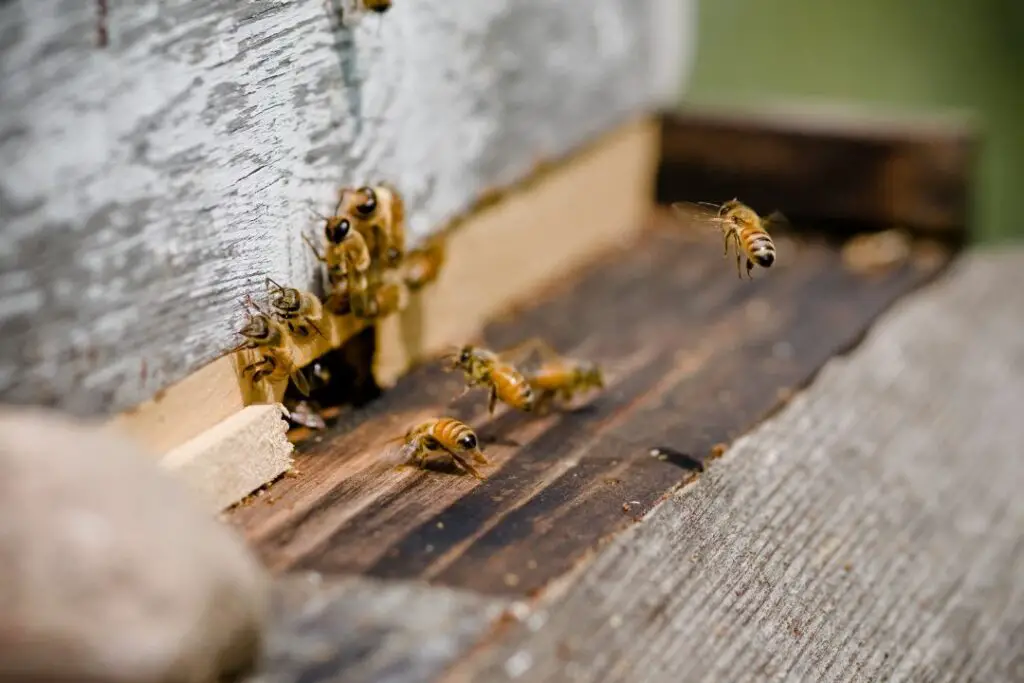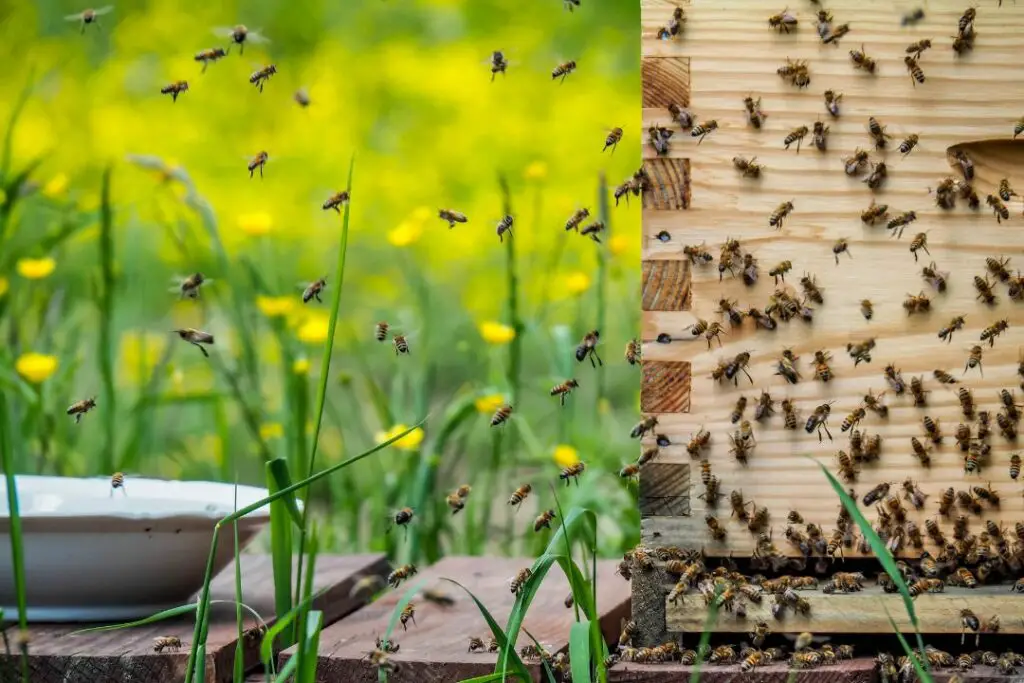Yes, on rare occasions, honey bees can join another hive. This phenomenon is called ‘drifting’. Bees will land at the entrance to another hive and try to gain entry past the vigilant guard bees.
But it’s not as simple as simply walking in. If they don’t behave precisely, they’ll be violently ejected or, worse, killed.
Let’s explore the flowers and delve into the world of bees to discover how and why bees try to switch colonies and the sometimes deadly consequences that follow.
How Do Bees Join Another Colony?
Bees drift usually because they’re either disorientated or wholly exhausted from collecting nectar and pollen.
It’s believed they land on a new hive as a matter of self-preservation in most instances rather than mistaking the hive for its own.
But much like if you tried to land at an international airport without permission, the encroaching bee will be quickly met by guard bees eager to check if they’re a colony member.
All bees from the same colony carry a distinct pheromone marker that can be used to distinguish each other from outsiders. When they notice the new visitor lacks this key chemical signal, it will have seconds to react before it’s set upon and removed.
Gaining access
For a bee to successfully migrate from one hive to another, it must pay a toll.
It does this by regurgitating nectar from its crop (stomach) as an offering to the waiting guard bees. If it’s accepted, the bee will gain access to the hive and its only chance of survival.
If a hive has a low population or has recently faced a significant loss, it might be more accepting of drifters.
Being rejected
If the offering is lacking or non-existent, the waiting bees have only one course of action. They take a defensive stance before shoving, biting, and stinging the intruder until it leaves or expires.
This is precisely the same response any insect would receive if they happened to wander too close or tried their luck at breaking into the hive. Want to know which insects hunt and eat bees?

Merging Hives
There are a few instances when beekeepers encourage a colony of bees to join another.
It happens for one of three reasons:
- A hive has lost its queen late in the season with no time to raise a new queen
- The current queen is only laying drones due to a lack of sperm in her spermatheca (what’s needed to lay healthy female worker bees and new virgin queens)
- A hive is very weak or has a meagre population with little to no food stores
Beekeepers do this by placing hives on top of one another with a sheet of newspaper separating the two sets of frames. This gives each colony time to familiarize themselves with the other’s scent before chewing through the separating paper to merge.
It’s essential that the merging hive is queenless, or it could lead to a fight between the two queens and the potential loss of both. It’s also good to check for diseases, parasites or pests that could negatively affect the new colony.
This strategy is especially useful during winters when a larger population generates more heat and improves the hive’s chances of making it through the cold months.
Why Do Bees Need To Search For A New Home?
Bees moving from hive to hive isn’t a regular occurrence. If they’re not lost or exhausted, chances are it’s because something’s meant they have to vacate their home.
Extreme weather, like powerful winds or floods, can quickly destroy bee hives, leaving the inhabitants homeless and running out of time.
Large predators can quickly level carefully crafted hives in seconds on the hunt for the sweet honey and larvae inside. Find out more about the animals that attack and eat bees here.

Drifters vs. Robbers
Discerning the difference between a drifter bee and a robber bee is crucial for a hive’s guards.
While drifters accidentally land on a foreign hive due to exhaustion or disorientation, robber bees intentionally raid other colonies. They usually come to steal honey, especially when flowers are scarce, and nectar is hard to come by.
Unlike drifters, they land purposefully and attack immediately to gain access to the hive.
Defensive Strategies of the Hive
The colony is not defenceless against these intruders. They have developed various strategies to ward off both drifters and robbers:
- Fortifying the Entrance: Many hives create a more narrow entrance, making it easier for guard bees to defend.
- Deploying More Guards: In times of frequent intrusion, the hive may deploy additional guard bees.
- Creating a Buzz: The entire hive can create a loud buzz, a warning signal to potential intruders.
Robber bees target weak colonies with low populations or suffering from pests and diseases. This makes the task of forcing entry much more manageable.
In Conclusion
The complex world of bees offers us a window into the intricate balance of nature. While ‘drifting’ and ‘robbing’ might seem like simple concepts, they highlight the sophisticated social structures and survival tactics bees employ.
By understanding these behaviours, we appreciate nature’s beauty and learn how to support these essential pollinators.
After all, our world would look much different without them. At Revive a Bee, we’re committed to ensuring these tiny wonders continue to thrive. Join us in this mission, and together, let’s create a buzz for bees!
Why not check out one of our other great reads below, packed with fascinating insights on nature’s hardest-working pollinators?





